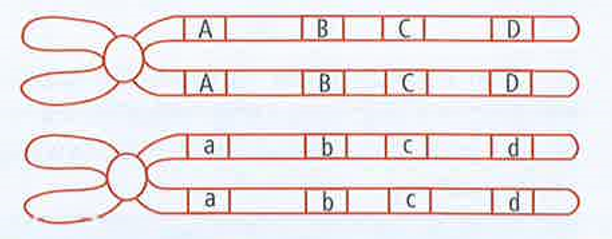Homologous chromosomes shows maximum attraction during :-
Leptotene
Zygotene
Pachytene
Diplotene
The correct Answer is:C
To determine when homologous chromosomes show maximum attraction, we need to analyze the stages of meiosis, particularly focusing on prophase I. Here’s a step-by-step breakdown of the solution:
1. Understanding Homologous Chromosomes: Homologous chromosomes are pairs of chromosomes that have the same structure and gene sequence, one inherited from each parent. They are crucial during meiosis for genetic recombination.
2. Identifying Stages of Meiosis: Meiosis consists of several stages, particularly during prophase I, which can be subdivided into five stages: leptotene, zygotene, pachytene, diplotene, and diakinesis.
3. Analyzing Each Stage:
- Leptotene: In this stage, chromosomes start to condense, but homologous chromosomes do not yet show significant attraction.
- Zygotene: Here, homologous chromosomes begin to pair up (synapsis) and form the synaptonemal complex. While there is some attraction, it is not at its maximum.
- Pachytene: This is the stage where crossing over occurs between non-sister chromatids of homologous chromosomes. This process involves the exchange of genetic material and represents the maximum attraction between homologous chromosomes.
- Diplotene: In this stage, the synaptonemal complex begins to disassemble, and the homologous chromosomes start to separate, leading to reduced attraction.
- Diakinesis: This is the final stage of prophase I where chromosomes condense further and prepare for metaphase, but the attraction is not at its peak.
4. Conclusion: Based on the analysis, the stage where homologous chromosomes show maximum attraction is during pachytene.
Final Answer:
Homologous chromosomes show maximum attraction during pachytene.
- Leptotene: In this stage, chromosomes start to condense, but homologous chromosomes do not yet show significant attraction.
- Zygotene: Here, homologous chromosomes begin to pair up (synapsis) and form the synaptonemal complex. While there is some attraction, it is not at its maximum.
- Pachytene: This is the stage where crossing over occurs between non-sister chromatids of homologous chromosomes. This process involves the exchange of genetic material and represents the maximum attraction between homologous chromosomes.
- Diplotene: In this stage, the synaptonemal complex begins to disassemble, and the homologous chromosomes start to separate, leading to reduced attraction.
- Diakinesis: This is the final stage of prophase I where chromosomes condense further and prepare for metaphase, but the attraction is not at its peak.
Homologous chromosomes show maximum attraction during pachytene.
Topper's Solved these Questions
- BOOK - MOTIONCHAPTER - CELL CYCLE AND CELL DIVISIONEXERCISE - Exercise - 217videos
CELL CYCLE AND CELL DIVISION
- BOOK - MOTIONCHAPTER - CELL CYCLE AND CELL DIVISIONEXERCISE - Exercise - 3 (AIPMT - 2009)2videos
CELL CYCLE AND CELL DIVISION
- BOOK - MOTIONCHAPTER - CELL CYCLE AND CELL DIVISIONEXERCISE - CHECK YOUR CONCEPTS-25videos
CELL CYCLE AND CELL DIVISION
- BOOK - MOTIONCHAPTER - BREATHING AND EXCHANGE OF GASESEXERCISE - Exercise 421videos
BREATHING AND EXCHANGE OF GASES
- BOOK - MOTIONCHAPTER - CELL THE UNIT OF LIFEEXERCISE - Excercise - 4 AIIMS | Assertion & Reason Questions39videos
CELL THE UNIT OF LIFE
Similar Questions
Knowledge Check
- Question 1 - Select One
Homologous chromosomes are
Amorphologically & genetically differentBmorphologically different but genetically similarCgenetically similarDchromosomes which pair during synapsis - Question 2 - Select One
Separation of the homologous chromosome of a pair occurs during
ACongressionBDisjunctionCBivalent formationDSynapsis - Question 3 - Select One
homologous chromosomes seperates during
AmetaphaseBanaphaseCmetaphaseDnone
Chromosomes are fully condensed and the meiotic spindle is assembled to prepare the homologous chromosomes for separation during
View SolutionWhat are homologous chromosomes?
View SolutionGiven diagram shows a pair of homologous chromosomes during meiosis

Maximum crossing over will occur between genesView Solutionhomologous chromosomes seperates during
View SolutionHomologous chromosomes begin to separate during
View Solution

